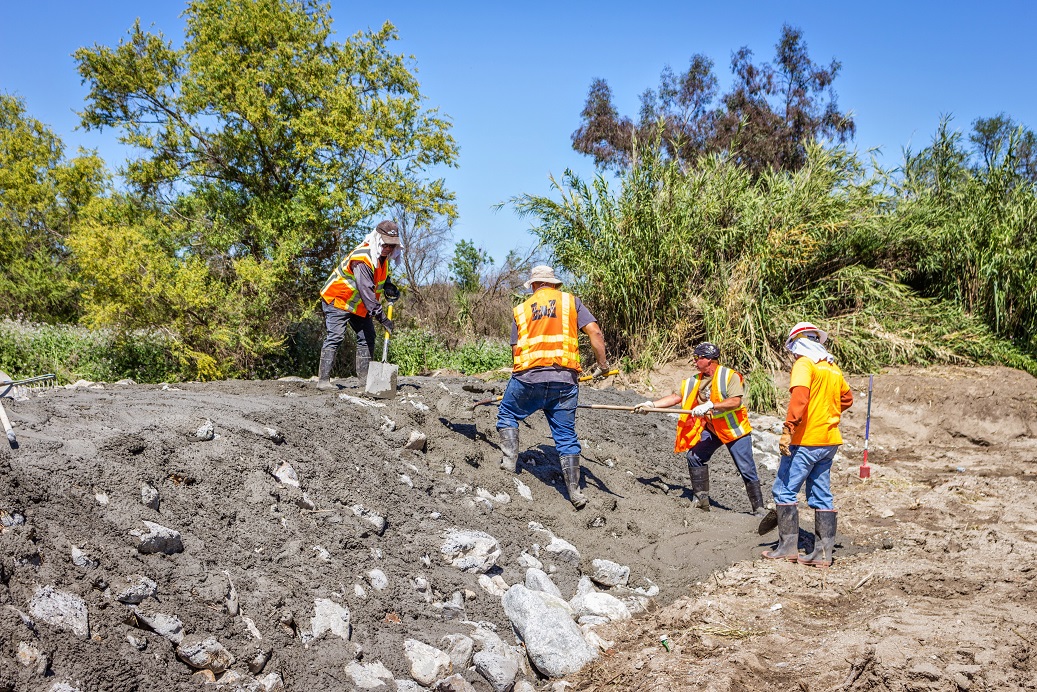
Santa Fe Dam and Reservoir is a flood control project in the Los Angeles County Drainage Area (LACDA) flood control system. The dam’s embankment is a horseshoe-shaped, curved gravity structure, located on the San Gabriel River, south of Azusa. The project was completed in January 1949. The primary purpose of the dam is to provide flood risk management to the communities along the San Gabriel River downstream of the Basin.
A total of 2,553.7 acres was acquired in fee for construction, operation, and maintenance of the Dam. The Corps reserves 1,271.7 acres exclusively for Dam operations. The remaining 1,282.0 acres are available for compatible purposes with a preference towards recreational purposes. The Corps granted a lease of approximately 835.77 acres in the Reservoir for recreation purposes to the County of Los Angeles.
For additional detailed physical data visit the Reservoir Regulation page. Additional information on Santa Fe Dam and Reservoir can be found in the Santa Fe Basin Master Plan.
Safety First

Keep yourself safe when visiting the many public facilities in the reservoir by being aware if the potential for storms is being forecast. The Reservoir is designed to hold back large quantities of water and can fill very quickly. Check the local weather forecast before enjoying the many recreational opportunities in and around the reservoir.
Environmental Resources
 The Corps evaluates environmental effects of all actions taken within the Dam and the Reservoir. Biological surveys are conducted in the Reservoir throughout the year by the Corps and the Corps partner agencies.
The Corps evaluates environmental effects of all actions taken within the Dam and the Reservoir. Biological surveys are conducted in the Reservoir throughout the year by the Corps and the Corps partner agencies.
The Reservoir includes of a variety of habitat types, including native communities, disturbed vegetation communities, agricultural land, constructed open water, disturbed wetlands, and developed parks or urbanized areas. Many wildlife species are found within the Reservoir. Species common to the Reservoir include native and non-native fishes, amphibians, reptiles, mammals, and birds.
The open water areas found in the Reservoir attract waterfowl and shorebirds such as American coots (Fulica americana) and ruddy ducks (Oxyura jamaicensis). Riparian and upland habitats host a diversity of passerine species such as Vaux swift (Chaetura vauxi). Bat species are also present and use the Reservoir for roosting, breeding, or as year-round residents. Only two amphibians are common, including the California toad and Pacific treefrog. Dry upland areas host common lizard and snake species. Non-native species such as feral cats and dogs are also found in the Reservoir.
Maintenance Activities

The Corps engages in routine maintenance activities within the operational areas of the Reservoir year round to maintain the operational capacity of the project. As congressionally appropriated funding allows, the Corps works to upgrade aging structures and systems. Annual maintenance activities at US Army Corps of Engineers operated dams include grading of access roads, vegetation removal, and an annual safety inspection. In addition, the control house, gates, and all mechanical and electrical equipment is checked at each dam to make sure that it is functioning in accordance with the Dam Operations Manual. Graffiti removal, clearing of debris and sediment, and additional repairs are performed to maintain the facility.
Review Upcoming Proposed Actions
To review public notices on our upcoming proposed maintenance activities please visit the Public Notice postings page or click the “Public Notice” link found in the navigational side bar.
Questions, Concerns, Comments?
Let us know by clicking the “Contact” button in the navigation bar and choose Operations Division as the recipient.
The appearance of external hyperlinks does not constitute endorsement by the U.S. Army of this Web site or the information, products, or services contained therein. For other than authorized activities such as military exchanges and MWR sites, the U.S. Army does not exercise any editorial control over the information you may find at these locations. Such links are provided consistent with the stated purpose of this Web site.